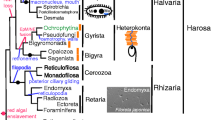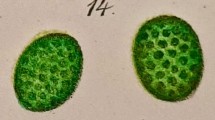Summary.
Microtubule dynamics were examined in live cells of the fungal plant pathogen Magnaporthe grisea transformed for constitutive expression of a fusion protein containing enhanced yellow-fluorescent protein and a Neurospora crassa benomyl-resistant allele of β-tubulin. Transformants retained their ability to differentiate appressoria and cause disease but remained sensitive to benomyl. Linear microtubule arrays and low-level cytoplasmic fluorescence were observed in vegetative hyphae, conidia, germ tubes, and developing appressoria. Fluorescence within nuclei was conspicuously absent during interphase but increased rapidly at the onset of mitosis. Treatment with either benomyl or griseofulvin resulted in the appearance of prominent brightly fluorescent aggregates, including a large aggregate near the apex, with the concomitant disappearance of most cytoplasmic microtubules. Electron microscope imaging of treated cells indicated that the aggregates lacked any obvious profiles of intact microtubules. During these treatments, hyphal tip cells continued to elongate in a nonlinear and aerial fashion at a much slower rate than untreated cells. With subsequent removal of griseofulvin, distal aggregates disappeared rapidly but the apical aggregates persisted longer. Treatment with latrunculin A caused hyphal tip swelling without apparent effect on linear microtubule arrays. Simultaneous treatment with griseofulvin and latrunculin A resulted in depolymerization of microtubules and a cessation of growth, but near-apical fluorescent aggregates were not observed.
Similar content being viewed by others
Abbreviations
- EYFP:
-
enhanced yellow-fluorescent protein
Author information
Authors and Affiliations
Corresponding author
Additional information
Correspondence and reprints: Department of Biological Sciences, University of Delaware, Newark, DE 19716, U.S.A.
Present address: Paradigm Genetics Inc., Research Triangle Park, North Carolina, U.S.A.
Electronic supplementary material
Figs. 1–10.
Single optical sections from living hyphal tip cells of MG156 expressing Ben::EYFP. Apical region during interphase illustrated fluorescence-tagged microtubules and general cytoplasmic fluorescence. Time series of a nucleus during mitosis with a continual capture rate of 10 s/frame. Note an increase in brightness within the nucleus at the onset of mitosis preceding mitotic spindle initiation. The spindle was initially oriented perpendicular to the longitudinal axis of the hypha but then rotated to become parallel during anaphase elongation. Note astral and nonastral cytoplasmic microtubules throughout the time sequence with a reduction in the width of the central spindle as mitosis progressed
Figs. 11–15.
Time series of single optical sections from a germ tube apex during treatment with 10 µg of griseofulvin per ml with a continual capture rate of 12.5 s/frame. Griseofulvin was applied immediately after the first frame was acquired. As microtubules depolymerized, aggregates of bright fluorescence developed typically with a larger aggregate forming near the apex. Apical aggregates exhibited peripheral fine filamentous elements that were oriented in a radial pattern. After 7.5 min of treatment, a prominent fluorescent aggregate at the apex was observed. Linear microtubule profiles were still visible after more than 20 min of treatment
Rights and permissions
About this article
Cite this article
Czymmek, K., Bourett, T., Shao, Y. et al. Live-cell imaging of tubulin in the filamentous fungus Magnaporthe grisea treated with anti-microtubule and anti-microfilament agents. Protoplasma 225, 23–32 (2005). https://doi.org/10.1007/s00709-004-0081-3
Received:
Accepted:
Published:
Issue Date:
DOI: https://doi.org/10.1007/s00709-004-0081-3




